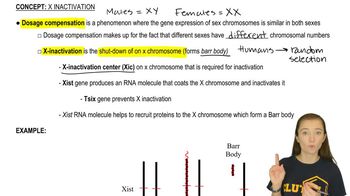Table of contents
- 1. Introduction to Genetics51m
- 2. Mendel's Laws of Inheritance3h 37m
- 3. Extensions to Mendelian Inheritance2h 41m
- 4. Genetic Mapping and Linkage2h 28m
- 5. Genetics of Bacteria and Viruses1h 21m
- 6. Chromosomal Variation1h 48m
- 7. DNA and Chromosome Structure56m
- 8. DNA Replication1h 10m
- 9. Mitosis and Meiosis1h 34m
- 10. Transcription1h 0m
- 11. Translation58m
- 12. Gene Regulation in Prokaryotes1h 19m
- 13. Gene Regulation in Eukaryotes44m
- 14. Genetic Control of Development44m
- 15. Genomes and Genomics1h 50m
- 16. Transposable Elements47m
- 17. Mutation, Repair, and Recombination1h 6m
- 18. Molecular Genetic Tools19m
- 19. Cancer Genetics29m
- 20. Quantitative Genetics1h 26m
- 21. Population Genetics50m
- 22. Evolutionary Genetics29m
2. Mendel's Laws of Inheritance
Sex-Linked Genes
Problem 25aSanders - 3rd Edition
Textbook Question
Lesch–Nyhan syndrome (OMIM 300322) is a rare X-linked recessive disorder that produces severe mental retardation, spastic cerebral palsy, and self-mutilation.
What is the probability that the first son of a man whose brother has Lesch–Nyhan syndrome will be affected?
 Verified step by step guidance
Verified step by step guidance1
Identify the inheritance pattern: Lesch–Nyhan syndrome is an X-linked recessive disorder.
Understand the family relationship: The man in question has a brother with the syndrome, indicating that their mother is a carrier of the disorder.
Determine the genetic status of the man: Since the disorder is X-linked recessive, and the man does not have the syndrome, he must have inherited a normal X chromosome from his mother.
Consider the genetic contribution to the son: The man will pass on his Y chromosome to his son, while the mother of the son will contribute one of her X chromosomes.
Calculate the probability: Since the mother of the son is not specified to be a carrier, assume she is not a carrier, resulting in a 0% probability of the son being affected.
 Verified video answer for a similar problem:
Verified video answer for a similar problem:This video solution was recommended by our tutors as helpful for the problem above
Video duration:
1mPlay a video:
Was this helpful?
Key Concepts
Here are the essential concepts you must grasp in order to answer the question correctly.
X-linked Recessive Inheritance
Lesch–Nyhan syndrome is an X-linked recessive disorder, meaning the gene responsible for the condition is located on the X chromosome. Males, having one X and one Y chromosome, are more likely to express the disorder if they inherit the affected X chromosome. Females, with two X chromosomes, can be carriers without showing symptoms unless both X chromosomes are affected.
Recommended video:
Guided course

X-Inactivation
Carrier Status and Family Genetics
In this scenario, the man's brother has Lesch–Nyhan syndrome, indicating that he has the affected X chromosome. The man himself does not have the syndrome, but he could be a carrier if he inherited a normal X chromosome from his mother. Understanding the carrier status of the parents is crucial for determining the probability of the son being affected.
Recommended video:
Guided course

Modern Genetics
Punnett Square Analysis
A Punnett square is a tool used to predict the genetic outcomes of a cross between two individuals. In this case, it can help visualize the probability of the man passing on either his normal X chromosome or the Y chromosome to his son. By analyzing the genetic contributions from both parents, one can calculate the likelihood of the son being affected by Lesch–Nyhan syndrome.
Recommended video:
Guided course

Chi Square Analysis

 7:56m
7:56mWatch next
Master Sex-Linked Genes with a bite sized video explanation from Kylia Goodner
Start learningRelated Videos
Related Practice
Textbook Question
In this chapter, we focused on extensions and modifications of Mendelian principles and ratios. In the process, we encountered many opportunities to consider how this information was acquired. On the basis of these discussions, what answers would you propose to the following fundamental questions?
For genes whose expression seems to be tied to the sex of individuals, how do we know whether a gene is X-linked in contrast to exhibiting sex-limited or sex-influenced inheritance?
293
views
